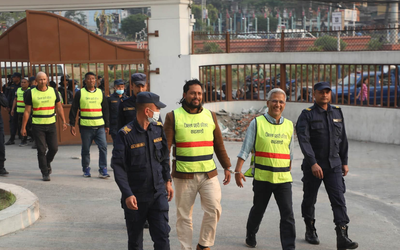More on News





U.S. Ambassador Peter W. Bodde and Secretary of Ministry of Culture, Tourism and Civil Aviation Sushil Ghimire jointly laid the foundation stone for the new seismically safe Crash Rescue and Fire Station Building at Tribhuvan International Airport today. The U.S. Government is providing assistance totaling $462,000 to build a new station and make it resistant to earthquakes. This work is part of a larger effort to improve critical infrastructure that will allow the airport to remain open if a major earthquake were to occur.
In his remarks recognizing the 16th annual Earthquake Safety Day, Ambassador Bodde said, “Two of my goals as the U.S. Ambassador are to support economic growth and reduce disaster risk in Nepal. Ultimately, we want to plan and prepare in a way that will save lives and destruction of property, lessen the impact of a disaster, and shorten the time of recovery. The United States is committed to helping Nepal improve its emergency response capacity.”
Different departments and agencies within the U.S. government have been actively collaborating to help reduce Nepal’s risk to natural disasters. Some of these programs include: national planning and training, hospital and warehouse retrofitting, creation of district-level Emergency Operations Centers, support for Nepal’s Department of Mines and Geology, construction of seven deep bore wells for emergency drinking water, creation of educational public service announcements, and joint humanitarian assistance exercises. The U.S. government has also supported the construction of a seismically safe blood bank at Tribuvhan University teaching hospital. Construction of that blood bank is underway. In addition to working with the Nepali government, the U.S. is working with the International Federation of Red Cross and Red Crescent Societies to pre-position emergency relief supply kits in Nepal, and with the International Organization for Migration (IOM) to prepare sites that can accommodate large numbers of people displaced following a large-scale disaster. The U.S. is also promoting a public-private partnership for earthquake risk management. The program seeks to demonstrate the private benefits of earthquake risk management and provide a business case for investing in risk reduction.







